Nucleotides Used for Metabolism and Signaling
Objective 3.11
3.11.1 Identify the features of an adenosine triphosphate (ATP) molecule that make it the energy currency of the cell.
3.11.2 Recognize nucleic acid which are used as cell-cell signals as well as those used as intracellular signaling molecules.
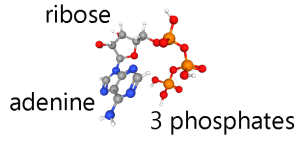
Nucleic acids are used in information storage, in metabolism and in signaling pathways. Rather surprisingly, the molecule adenosine triphosphate (ATP, adenine + ribose + three phosphate groups) is involved in all three functions. In a subcellular compartment called a mitochondrion, oxygen and glucose are converted to cellular energy which is then stored as high-energy phosphate bonds in a molecule called adenosine triphosphate (ATP).
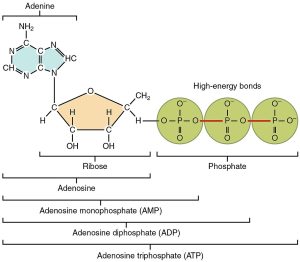
Remember that AMP is one of the nucleotide monomers which makes up the RNA polymer. Add two more phosphate (PO4) groups, and the molecule is now ATP.
Cellular pathways that require energy are adapted to use ATP as their energy source.
This is why we call ATP the energy currency. In economics, currency is needed to avoid having to barter one form of labor for another.
For the cell, it is more efficient to convert all forms of labor (energy) to one currency, which can be freely exchanged between different molecules. Splitting the phosphate group off 1 mole (6.02 x 1023 molecules) of ATP produces enough energy to run a 10-watt light bulb. Climbing a flight of stairs requires continuous burning of 20 moles of ATP. That means 1.2 x 1025 phosphate bonds, or 12,000,000,000,000,000,000,000,000 molecules of ATP, are consumed each time you take one flight of stairs.
ATP is also used as a molecule that sends a nerve signal between cells. This is especially important in the vascular system, where ATP causes the contraction of the muscles that line blood vessels.
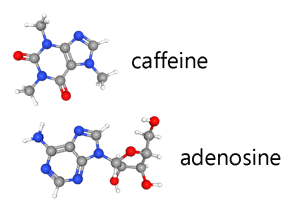 The related nucleotides adenosine diphosphate (ADP), uridine diphosphate (UDP), uridine triphosphate (UTP), UDP-glucose, and the nucleoside adenosine all act on the same set of receptors which are called purinergic because they bind the purine adenosine. Caffeine is a commonly used drug which acts at these purinergic receptors and can relieve migraine headaches in some patients by causing contraction of the muscle lining of blood vessels in the scalp and brain.
The related nucleotides adenosine diphosphate (ADP), uridine diphosphate (UDP), uridine triphosphate (UTP), UDP-glucose, and the nucleoside adenosine all act on the same set of receptors which are called purinergic because they bind the purine adenosine. Caffeine is a commonly used drug which acts at these purinergic receptors and can relieve migraine headaches in some patients by causing contraction of the muscle lining of blood vessels in the scalp and brain.
Nucleotides are also used as important intracellular signals. When we study the nervous system and endocrine system, we will see how cells use the intracellular signaling molecules cyclic adenosine monophosphate (cyclic AMP, cAMP) and cyclic guanosine monophosphate (cyclic GMP, cGMP) to carry messages within the cell. In these molecules, instead of hooking the phosphate to two separate nucleotide molecules, the same phosphate comes around and attaches to both the 3’ and 5’ carbon of the same ribose moiety. (Moiety, from the French moitié, means “piece” or “part”.) Thus the phosphate makes a sort-of ring which is the “cyclic” part of the molecule name.
| cGMP | 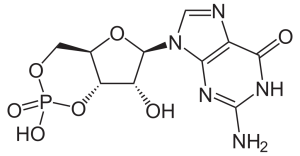 |
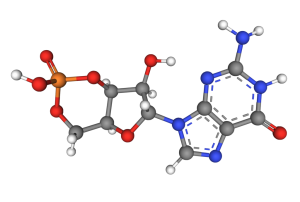 |
| cAMP |  |
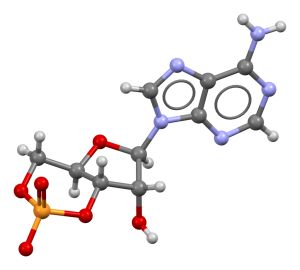 |
cGMP is a universal signaling molecule that changes the internal metabolism of cells. For example, the hormone adrenaline (also called epinephrine) acts by increasing cGMP levels inside cells; the cGMP level inside heart muscle cells increases and your heartbeat speeds up when you get a burst of adrenaline.
cAMP participates in pathways that turn genes on and off on the DNA molecule. When you read this, cAMP levels in key brain cells increase, and those cells both change their chemistry and form new connections. Thus, you remember what you have read about cAMP. It’s kinda cool and kinda weird that reading about cAMP changes your cAMP levels, reading about changes in gene expression changes your gene expression through a cAMP-mediated process, and reading about new connections between nerve cells means that new connections are formed.
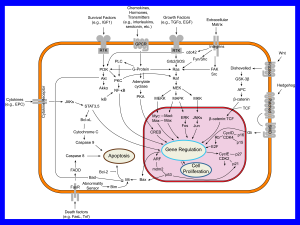
The intracellular signaling molecules we’ve been introduced to play a key role in health and disease. It’s not at all important for this course for you to learn any of them, but as you advance in your health career, you will find that the pathways shown on this diagram will be mentioned.
Note the central roles of apoptosis, gene regulation, and cell proliferation. Apoptosis is a kind of planned cell death which is important for both fetal development and disease at the other end of life. Increased apoptosis, for example, is probably the mechanism behind Alzheimer disease as well as a large variety of other diseases. Gene regulation is critical both for normal development, response to injury, as well as for cellular defenses. Cell proliferation is abnormal in cancer cells, as we will discuss briefly in Unit 5.
In Unit 4, we will be introduced to the G protein-coupled receptor (GPCR), seen here at the top of this diagram. The thick orange line represents the cell membrane; the gray squiggles are proteins which pick up a signal on the outside of the cell and turn it into an intracellular signal. This category of proteins, that pick up extracellular signals, are called receptors and we will study them in Unit 4 and then pretty much every unit from 8 to 20. Receptors, as can be seen here, trigger changes in the internal biochemistry of the cell as shown by the complex network of thin black arrows. The intracellular signaling molecules you are learning about in this Unit are the arrows that connect different biochemical pathways in the cell. (Pointy arrows indicate activation; arrows ending in a T indicate these are blocking a pathway.
Media Attributions
- U03-112 Adenosine-5′-triphosphate_Conformer3D_large © Hutchins, Jim is licensed under a Public Domain license
- U03-113 adenosine triphosphate openstax © Betts, J. Gordon; Young, Kelly A.; Wise, James A.; Johnson, Eddie; Poe, Brandon; Kruse, Dean H. Korol, Oksana; Johnson, Jody E.; Womble, Mark & DeSaix, Peter is licensed under a CC BY (Attribution) license
- U03-114 caffeine © Hutchins, JIm is licensed under a Public Domain license
- U03-115a cGMP line © NEUROtiker is licensed under a Public Domain license
- U03-115b cGMP ball and stick © QuantumProtein is licensed under a CC BY-SA (Attribution ShareAlike) license
- U03-116a cAMP line © NEUROtiker is licensed under a Public Domain license
- U03-116b cAMP ball and stick © Mills, Ben is licensed under a Public Domain license
- U03-119 signal transduction pathways © cybertory adapted by Jim Hutchins is licensed under a CC BY-SA (Attribution ShareAlike) license

